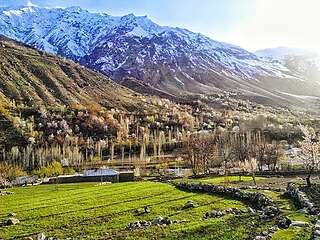
Persian, also known by its endonym Farsi, is a Western Iranian language belonging to the Iranian branch of the Indo-Iranian subdivision of the Indo-European languages. Persian is a pluricentric language predominantly spoken and used officially within Iran, Afghanistan, and Tajikistan in three mutually intelligible standard varieties, namely Iranian Persian, Dari Persian and Tajiki Persian. It is also spoken natively in the Tajik variety by a significant population within Uzbekistan, as well as within other regions with a Persianate history in the cultural sphere of Greater Iran. It is written officially within Iran and Afghanistan in the Persian alphabet, a derivative of the Arabic script, and within Tajikistan in the Tajik alphabet, a derivative of the Cyrillic script.

Tajiks are a Persian-speaking Iranian ethnic group native to Central Asia, living primarily in Afghanistan, Tajikistan, and Uzbekistan. Tajiks are the largest ethnicity in Tajikistan, and the second-largest in Afghanistan and Uzbekistan. They speak varieties of Persian, a Western Iranian language. In Tajikistan, since the 1939 Soviet census, its small Pamiri and Yaghnobi ethnic groups are included as Tajiks. In China, the term is used to refer to its Pamiri ethnic groups, the Tajiks of Xinjiang, who speak the Eastern Iranian Pamiri languages. In Afghanistan, the Pamiris are counted as a separate ethnic group.

Dari, also known as Dari Persian, is the variety of the Persian language spoken in Afghanistan. Dari is the term officially recognised and promoted since 1964 by the Afghan government for the Persian language; it is known as Afghan Persian or Eastern Persian in many Western sources. As Professor Nile Green remarks, "the impulses behind renaming of Afghan Persian as Dari were more nationalistic than linguistic" in order to create an Afghan state narrative. Apart from a few basics of vocabulary, there is little difference between formal written Persian of Afghanistan and Iran; the languages are mutually intelligible. The term "Dari" is officially used for the characteristic spoken Persian of Afghanistan, but is best restricted to formal spoken registers. Afghanistan's Persian-speaking population still prefer to call their language "Farsi", asserting that the term "Dari" has been imposed upon them by the dominant Pashtun ethnic group as an effort to detach Afghanistan from its deep-rooted cultural, linguistic, and historical connections with the wider Persian-speaking world, encompassing Iran, Tajikistan, and parts of Uzbekistan. It serves as the lingua franca for interethnic communications in Afghanistan.

Hazaragi is an eastern dialect and variety of the Persian language that is spoken by the Hazara people, primarily in the Hazaristan (Hazarajat) region of central Afghanistan, as well as other Hazara-populated areas of Afghanistan. Hazaragi is also spoken by the Hazaras of Pakistan and Iran, and also by the Hazara diaspora living elsewhere.

Tajik, also called Tajiki Persian or Tajiki, is the variety of Persian spoken in Tajikistan and Uzbekistan by Tajiks. It is closely related to neighbouring Dari of Afghanistan with which it forms a continuum of mutually intelligible varieties of the Persian language. Several scholars consider Tajik as a dialectal variety of Persian rather than a language on its own. The popularity of this conception of Tajik as a variety of Persian was such that, during the period in which Tajik intellectuals were trying to establish Tajik as a language separate from Persian, prominent intellectual Sadriddin Ayni counterargued that Tajik was not a "bastardised dialect" of Persian. The issue of whether Tajik and Persian are to be considered two dialects of a single language or two discrete languages has political sides to it.

Wakhi is an Indo-European language in the Eastern Iranian branch of the language family spoken today in Wakhan District, Northern Afghanistan and also in Tajikistan, Northern Pakistan and China.
The Pamir languages are an areal group of the Eastern Iranian languages, spoken by numerous people in the Pamir Mountains, primarily along the Panj River and its tributaries.

The Munji language, also known as Munjani (مونجانی), Munjhan (مونجهان), and the Munjiwar language, is a Pamir language spoken in Munjan valley in Badakhshan Province in northeast Afghanistan. It is similar to the Yidgha language, which is spoken in the Upper Lotkoh Valley of Chitral, west of Garam Chashma in Khyber Pakhtunkhwa, Pakistan.

New Persian, also known as Modern Persian and Dari Persian is the current stage of the Persian language spoken since the 8th to 9th centuries until now in Greater Iran and surroundings. It is conventionally divided into three stages: Early New Persian, Classical Persian, and Contemporary Persian.

Ishkashimi is an Iranian language spoken predominantly in the Badakhshan Province in Afghanistan and in Gorno-Badakhshan Autonomous Region in Tajikistan.

The Sarikoli language is a member of the Pamir subgroup of the Southeastern Iranian languages spoken by the Pamiris of Xinjiang, China. It is officially referred to in China as the "Tajik language", although it is different from the related Iranian language spoken in Tajikistan, which is considered a dialect of Persian.

The Pamiris are an Eastern Iranian ethnic group, native to the Badakhshan region of Central Asia, which includes the Gorno-Badakhshan Autonomous Region of Tajikistan; the Badakhshan Province of Afghanistan; Taxkorgan Tajik Autonomous County in Xinjiang, China; and the Upper Hunza Valley in Pakistan.

Central Asian Arabic or Jugari Arabic is a variety of Arabic currently facing extinction and spoken predominantly by Arab communities living in portions of Central Asia.

South Asia is home to several hundred languages, spanning the countries of Afghanistan, Bangladesh, Bhutan, India, Maldives, Nepal, Pakistan, and Sri Lanka. It is home to the third most spoken language in the world, Hindi–Urdu; and the sixth most spoken language, Bengali. The languages in the region mostly comprise Indo-Iranic and Dravidian languages, and further members of other language families like Austroasiatic, Turkic, and Tibeto-Burman languages.
Tajiks in Pakistan are residents of Pakistan who are of Tajik ancestry. The Tajiks are a Persian-speaking Iranian ethnic group native to Central Asia, living primarily in Afghanistan, Tajikistan, and Uzbekistan.
Iranian Persian, Western Persian or Western Farsi, natively simply known as Persian, refers to the varieties of the modern Persian language spoken in Iran and by minorities in neighboring countries, as well as by Iranian communities throughout the world. These are mutually intelligible with other varieties of Persian, including Afghanistan's Dari and Tajikistan's Tajiki.

Garam Chashma is one of the many branch valleys of Chitral District, situated in the extreme north-west of Pakistan. It is one of the highest human settlements in the Hindukush ranges with an altitude of almost 2550 meters. The place is known for its hot spring, which is one of the tourist attraction sites. It is also famous for its trout fish. The water flowing down through the length of the valley is famous for fishing sports. The Lotkoh River running down from the lofty peaks of the Hindu Kush is most suitable for the brown type of trout fish. Other features of the area include snow-covered peaks, pleasant weather, and natural springs, and more recently, has remained in the limelight for being a potential site of hydropower generation. Besides tourists, people suffering from skin diseases also visit the hot spring for treatment. It is located in the northwest of Chitral at a distance of about forty-eight kilometres by road. It shares international borders with Afghanistan being situated in the extreme northwest of Pakistan. Dorāh Pass connects this part of Pakistan with Badakhshan, the adjacent province of Afghanistan.

Lower Chitral District is a district in Malakand Division of Khyber Pakhtunkhwa province in Pakistan.
The Yidgha-Munji people also known as Mukhbani are the Iranian-Pamiri peoples inhabiting the Lotkoh Valley in Chitral and Kuran wa Munjan District in Badakhshan in both Pakistan and Afghanistan.
Madaklasht is a valley located in Lower Chitral district, Khyber Pakhtunkhwa, Pakistan. The valley is predominantly inhabited by the Tajik people who speak Madaklashti, a dialect of Persian.














